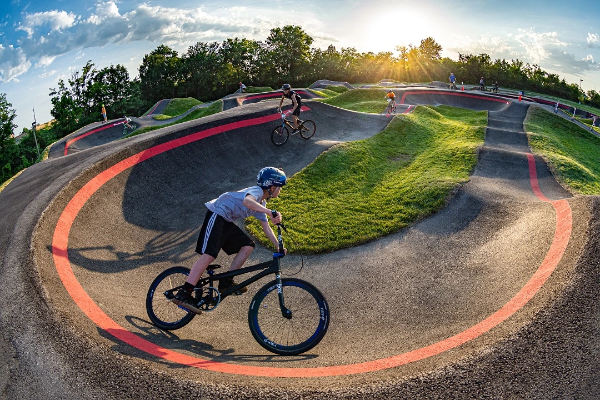A bicycle pump track is a specially designed circuit with rolling terrain features such as bumps, banked turns, and jumps that are used for cycling and other wheeled sports. The purpose of a bicycle pump track is to provide a safe and fun environment for cyclists to practice their skills, improve their technique, and build their confidence on a variety of terrain features.Riders navigate the track using momentum gained from pumping—using body movements to propel forward—rather than pedaling continuously.
Construction of a Bicycle Pump Track
A bicycle pump track is typically constructed using a combination of natural and man-made materials such as dirt, gravel, and concrete. The design of the track includes various features such as berms, rollers, and jumps that are arranged in a continuous loop. The construction process requires careful planning, excavation, and compaction to ensure that the track is stable and durable.
Use of a Bicycle Pump Track
A bicycle pump track can be used by both beginner and advanced cyclists to practice their skills and improve their technique. It can also be used for racing and competitions. The track provides a challenging and exciting environment for cyclists to test their limits and push themselves to new levels of performance.
Safety Precautions for Bicycle Pump Track Use
While a bicycle pump track is a great way to improve your cycling skills, it is important to prioritize safety when using the track. Safety measures such as wearing protective gear, following proper etiquette, and adhering to rules and regulations should be emphasized. Additionally, it is important to start slow and gradually work your way up to more challenging features on the track.
Origins and Evolution
The concept of pump tracks originated in the mountain biking community, evolving from BMX tracks and dirt jumps. Early tracks were rudimentary, often hand-built by enthusiasts in vacant lots or public parks. As interest grew, municipalities and cycling organizations began constructing purpose-built pump tracks to cater to the demand for recreational cycling facilities.
Design and Layout
Pump tracks are typically constructed from compacted dirt, though some may feature asphalt or concrete surfaces. The layout consists of a continuous loop with alternating features such as berms, rollers, and occasionally, jumps. The track’s design encourages riders to maintain momentum through rhythmic pumping and leaning into the turns.
Benefits of Riding
Riding a pump track offers several physical and mental benefits. It enhances cardiovascular fitness and leg strength while improving balance and coordination. The repetitive motion of pumping builds muscle endurance and stamina, making it an effective cross-training activity for cyclists of all disciplines.
See Also: What Are the Benefits of Riding a Bike Everyday
Accessibility and Inclusivity
One of the key advantages of pump tracks is their accessibility. Unlike technical mountain bike trails or high-speed downhill courses, pump tracks cater to a wide range of skill levels and ages. Beginners can develop fundamental riding skills in a controlled environment, while experienced riders can refine techniques and challenge themselves with faster lap times.
Community Impact
Pump tracks contribute positively to communities by promoting outdoor recreation and active lifestyles. They serve as gathering places for cyclists and families, fostering a sense of camaraderie and social interaction. Local businesses often benefit from increased foot traffic generated by visitors to the track.
Construction and Maintenance
Building a pump track requires careful planning and expertise in trail design. Depending on the terrain and budget, tracks may be built using heavy machinery or hand tools by skilled trail builders. Maintenance involves periodic grooming and repair of erosion-prone areas to ensure safe riding conditions and preserve the track’s integrity.
Environmental Considerations
Environmental stewardship is crucial in pump track construction and maintenance. Sustainable practices such as soil conservation, native plant restoration, and erosion control help minimize the track’s impact on surrounding ecosystems. Local regulations and environmental assessments may influence track design and location.
Global Popularity
Pump tracks have gained popularity worldwide, from urban parks to rural communities and international cycling events. Their versatility and relatively low construction cost compared to other cycling facilities make them accessible to diverse geographic regions and socioeconomic backgrounds.
Educational Opportunities
Pump tracks provide educational opportunities for youth and aspiring cyclists. Skills clinics, workshops, and competitive events hosted at tracks encourage skill development and sportsmanship. Cycling organizations often collaborate with schools and community centers to promote cycling safety and healthy lifestyles.
Future Trends
The future of pump tracks includes advancements in track design and construction materials. Innovations such as modular pump track systems and digital mapping tools streamline planning and installation processes. Increased integration of pump tracks into urban planning and recreational infrastructure reflects growing recognition of cycling as a sustainable mode of transportation and leisure activity.
Conclusion
In conclusion, a bicycle pump track is a fantastic way to improve your cycling skills while having fun in a safe and controlled environment. By following proper safety precautions and gradually increasing the difficulty of the features on the track, you can build your confidence and become a more skilled cyclist. So why not give it a try? You might surprise yourself with what you can achieve!

